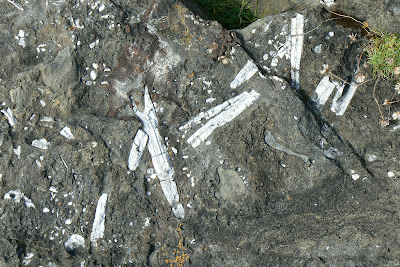 The prime interest of geologists who come to Ardnamurchan is usually its volcanoes, yet there are hidden fossil treasures to be found if you know where to look.
The prime interest of geologists who come to Ardnamurchan is usually its volcanoes, yet there are hidden fossil treasures to be found if you know where to look.At first glance, these white marks on rocks along the Ormsaigbeg shore don't look particularly exciting, yet they are the remains of a mollusk which lived in the seas which covered this area over 100 million years ago.
 That animal was a Belemnite, and the photo above shows a reasonably complete specimen. It is, of course, the hard parts only, as the soft parts were lost long ago.
That animal was a Belemnite, and the photo above shows a reasonably complete specimen. It is, of course, the hard parts only, as the soft parts were lost long ago.The skeleton consists of an elongate, bullet-shaped calcitic structure with what appears to be a conical hole bored into the wider end. In front of this, but lost in almost all specimens, was a much more fragile, spoon-like structure, also made of calcite.
 Although Belemnites are long-extinct, they do have living relatives, one of which is the cuttlefish. This cuttlefish skeleton, or 'bone', is the equivalent of the Belemnite's spoon-shaped structure, the 'bullet' being an extension onto this.
Although Belemnites are long-extinct, they do have living relatives, one of which is the cuttlefish. This cuttlefish skeleton, or 'bone', is the equivalent of the Belemnite's spoon-shaped structure, the 'bullet' being an extension onto this. One imagines, therefore, that Belemnites were remarkably similar to cuttlefish, but perhaps a little more elongate. From well-preserved specimens, it's known that they had eyes and tentacles just like these, and that they lived in similar marine environments. Perhaps they also had the cuttlefish's amazing ability to change colours.
One imagines, therefore, that Belemnites were remarkably similar to cuttlefish, but perhaps a little more elongate. From well-preserved specimens, it's known that they had eyes and tentacles just like these, and that they lived in similar marine environments. Perhaps they also had the cuttlefish's amazing ability to change colours.
No comments:
Post a Comment